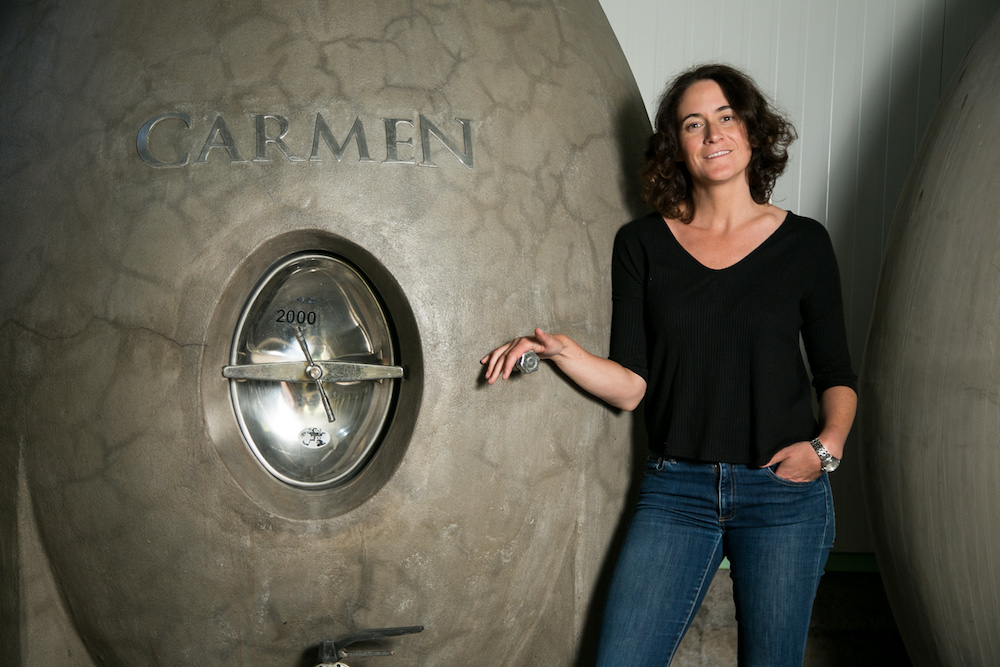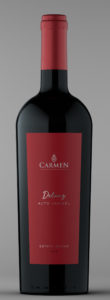Maipo has become synonymous with Cabernet, and Maipo Andes (or Alto Maipo) in particular has become synonymous with world-class Cabernet Sauvignon. As part of our Terroir Talk series, we talk with Emily Faulconer, winemaker at Viña Carmen in Alto Jahuel to discuss why the alluvial soils and mountain climate are key to the character of Maipo Cabernet Sauvignon.
In this talk, Emily shares her vision of Maipo and how the winemaking influences have changed over the years, and we taste through two landmark wines for the winery: the Grand Reserva Cabernet Sauvignon which paints a picture of the Alto Jahuel expression of Cabernet Sauvignon, and the delicious Cabernet Sauvignon-Cabernet Franc-Petit Verdot-Petite Sirah blend Delanz which is her vision of the nuance of Alto Jahuel terroir.
Emily explains the process of Viña Carmen’s replant of an important area of the vineyard and how they planned the plots in terms of exposure, soils, genetic material and trellising system, and they discuss the value of old vines and new for making Cabernet Sauvignon. As Chile’s most-planted variety, Emily also discusses why she thinks it rose to fame and the future of the variety in the region.
Carmen Grand Reserva Cabernet Sauvignon
For me, this is a classic expression of Cabernet Sauvignon from Maipo Alto with beautifully fresh red and black forest fruit aromas with layers of cedar, rosehips and graphite. It’s incredible value (around USD$18, £15) and offers a classy and precise expression of this mountainous terroir.
- Maipo Valley, Alto Jahuel
- 100% Cabernet Sauvignon
- Alcohol: 13.5% vol
- Winemaker: Emily Faulconer
- Grapes are handpicked from Carmen´s owned vineyards. After alcoholic fermentation the wine is aged in French Oak barrels for 14 months.
- The wine comes from the Quillayes vineyard in Alto Maipo Chile. This vineyard is planted over alluvial terraces and has a mixture of 20% clay and 80% sand, providing the vines with outstanding drainage balanced with optimum moisture retention. The significant fluctuation between day and night gives the wine balanced acidity and since this variety needs warm temperature, the Maipo valley is perfect for this! The high altitude of the Andes also helps cool down the temperature at night.
Viña Carmen Delanz 2018
I’m so excited about this blend – it exudes elegance and whispers of the sunny, fragrant days and the cool, crisp nights of Alto Maipo. This seductive blend has notes of juicy red berries, meadow flowers and has fine tannins and a fresh finish that lures you in for another sip.
Maipo Valley, Alto Jahuel
- 76% Cabernet Sauvignon, 16% Cabernet Franc, 5% Petit Verdot, 3% Petite Sirah
- Alcohol: 13.5 % vol
- Winemaker: Emily Faulconer
- Total Acidity: 5.1 g/l (expressed in Tartaric Acid)
- pH: 3.7
- Residual Sugar: 2.27 g/l
- Vineyard: This is the first version of Delanz, it is a red blend of our Alto Jahuel vineyard. This vineyard has 600 ha. As expected on a surface like this, there are many different realities. It is surrounded by hills and has different geological formations, slopes, altitudes, soil textures. This is why it has different varieties planted. With Delanz, we seek to reflect the identity of Alto Jahuel through a mixture of specific blocks, which allow us to interpret the territory as a whole.
- Vinification: The grapes were harvested by hand early in the morning and taken to the cellar in small boxes of 12 kg. They passed through an optical selection before entering the tank. The fermentation took place in stainless steel tanks at 23 °-28 ° C (73 ° -82 ° F). The maceration period was 24 days. The skins went to a vertical press, using different pressures to obtain the press wine, which was then used in the final blend. The wine was aged in French oak barrels for 18 months, clarification and stabilization took place naturally during this period.
- Read more about Viña Carmen in our winery guide.


